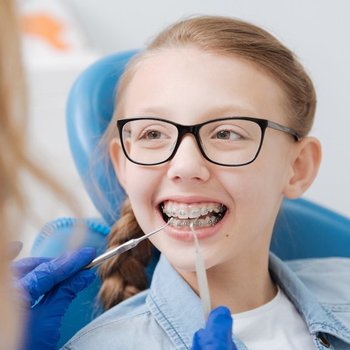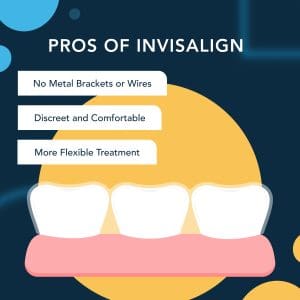Choosing between braces and Invisalign can be a tough decision, as both options effectively straighten crooked teeth and improve your smile. Factors like treatment time, cost, and lifestyle play a role in determining the best choice. Whether you need significant adjustments or a subtle fix, understanding the pros and cons of each will help you make the right decision.
How Do Braces and Invisalign Work?
Both braces and Invisalign gradually move crooked teeth into proper alignment, but they do so in different ways. Braces use metal or ceramic brackets with wires that apply continuous pressure to shift teeth over time. Invisalign, on the other hand, relies on clear, removable aligners that gently adjust your smile without brackets or wires. While braces are ideal for more complex dental issues, Invisalign offers a discreet, comfortable alternative for mild to moderate corrections. Your dentist can help determine the best option for you.
What are the Pros of Traditional Braces?
Traditional braces are a reliable and time-tested solution for straightening crooked teeth and correcting bite issues. They are highly effective for treating even the most complex dental misalignments. Unlike removable aligners, braces work continuously without relying on patient compliance. With advancements in design, options like ceramic braces offer a less noticeable alternative.
Effective for All Types of Orthodontic Issues
Braces are the go-to solution for correcting even the most severe alignment problems, including crooked teeth, overbites, underbites, and significant spacing issues. Unlike Invisalign, which is best for mild to moderate cases, braces provide controlled, consistent pressure, making them effective for all ages and all levels of orthodontic complexity.
Often More Affordable Than Invisalign
Traditional braces are often a more budget-friendly option compared to Invisalign. While costs vary based on treatment complexity, braces typically require fewer replacements or adjustments. Also, many insurance plans cover braces, making them a practical choice for families looking for a cost-effective way to achieve a straighter, healthier smile without breaking the bank.
Faster Treatment for Certain Cases
For some patients, braces can work faster than Invisalign, especially for complex cases. Since they apply continuous pressure without the need for removal, they can efficiently move teeth into place. In cases of severe misalignment, braces may reduce overall treatment time compared to clear aligners, which require compliance from the patient.
Customization Options with Bracket Colors
One fun advantage of braces is the ability to personalize them with colorful bands. Patients can choose from a variety of colors to match their personality, favorite team, or even the season. For those wanting a more subtle look, clear or tooth-colored brackets offer a discreet alternative to traditional metal braces.
What are the Cons of Traditional Braces?
While braces are highly effective, they do come with some drawbacks. The metal brackets and wires are noticeable, which may be a concern for some patients. Braces can also cause discomfort, especially after adjustments, and require dietary restrictions to prevent damage. Additionally, maintaining proper oral hygiene can be more challenging.
More Noticeable Than Invisalign
One of the biggest drawbacks of traditional braces is their visibility. The metal brackets and wires are noticeable, which can make some patients feel self-conscious. While ceramic braces offer a more discreet option, they’re still more visible than Invisalign, which uses clear aligners for a nearly invisible orthodontic treatment.
Discomfort and Potential Irritation
Braces can cause discomfort, especially after adjustments when the pressure increases to shift teeth. The metal brackets and wires may also irritate the inside of the mouth, leading to sore spots or minor cuts. While orthodontic wax can help reduce irritation, some patients find the initial adjustment period uncomfortable.
Food Restrictions and Dietary Limitations
Certain foods must be avoided with braces to prevent damage to the brackets and wires. Sticky foods like caramel, hard foods like nuts, and chewy foods like bagels can pose a risk. Unlike Invisalign, which is removable, braces require extra caution when eating to avoid unnecessary complications or repairs.
More Difficult to Maintain Oral Hygiene
Brushing and flossing with braces requires extra effort to keep teeth and tooth enamel healthy. Food can easily get stuck around brackets and wires, increasing the risk of poor oral hygiene, cavities, and periodontal disease. Special tools like floss threaders and interdental brushes help, but cleaning takes more time and care.
Frequent Dental Visits for Adjustments
Braces require regular checkups for tightening and adjustments, usually every 4–6 weeks. These visits are necessary to ensure steady progress but can be inconvenient for those with busy schedules. Compared to Invisalign, which often requires fewer in-office visits, braces demand more frequent trips to the orthodontist for proper maintenance.
What are the Pros of Invisalign?
There are plenty of pros to Invisalign, making it a popular choice for those looking to straighten their teeth. Invisalign offers a discreet and comfortable way to correct misalignment without the hassle of metal brackets and wires. With fewer restrictions and a more flexible treatment process, Invisalign provides a convenient and effective alternative to traditional braces.
 Nearly Invisible Appearance
Nearly Invisible Appearance
One of Invisalign’s biggest advantages is its clear, discreet design. The aligners are nearly invisible, making them a great option for adults and teens who want to straighten their crooked teeth without the look of traditional braces. This subtle appearance allows for greater confidence throughout the treatment process.
Removable for Eating and Cleaning
Unlike braces, Invisalign aligners can be removed for meals, allowing you to eat whatever you like without restrictions. They also make maintaining oral hygiene easier, as you can brush and floss without working around brackets and wires. This removability ensures better long-term dental health while undergoing orthodontic treatment.
More Comfortable Than Braces
Invisalign aligners are made of smooth plastic, eliminating the risk of irritation from metal brackets and wires. While mild pressure is still applied to move teeth, there are no sharp edges to cause discomfort. Many patients find Invisalign a more comfortable alternative, especially compared to the tightening of traditional braces.
Fewer Office Visits Required
With Invisalign, there’s no need for frequent adjustments like with braces. Instead of monthly tightening appointments, you’ll typically check in with your dentist or orthodontist every 6–8 weeks. This makes Invisalign a convenient choice for those with busy schedules who want an effective yet low-maintenance orthodontic solution.
No Food Restrictions
Since Invisalign aligners are removable, you can enjoy all your favorite foods without restrictions. Unlike traditional braces, which require avoiding sticky, hard, or chewy foods, Invisalign lets you eat freely without worrying about damage. Simply take out your aligners before meals, enjoy your food without limitations, and brush your teeth before putting them back in for a hassle-free experience.
What are the Cons of Invisalign?
While Invisalign offers a discreet and flexible way to straighten crooked teeth, it’s not perfect for everyone. The aligners require strict discipline, as they must be worn 20–22 hours a day for effective results. Invisalign may also be less effective for severe misalignment and can be more expensive than traditional braces.
Requires Discipline to Wear 22+ Hours a Day
To be effective, Invisalign aligners must be worn at least 22 hours daily. Forgetting to wear them or frequently removing them can delay progress and extend treatment time. Unlike braces, which work continuously, Invisalign relies on patient compliance, making it a less ideal option for those who may struggle with consistency.
May Not Be Suitable for Severe Cases
Invisalign is best for mild to moderate misalignment. Severe bite issues, large gaps, or complex crooked teeth cases may require traditional braces for proper correction. While Invisalign has advanced over the years, it may not provide the same level of control needed for more complicated orthodontic treatments.
Can Cause Speech Adjustments Initially
Some patients experience slight speech problems when they first start wearing Invisalign. The aligners can create a slight lisp or difficulty pronouncing certain words as the tongue adjusts. While most people adapt within a few days, this temporary adjustment can be frustrating, especially for those who speak frequently for work or social situations.
Can Be Lost or Damaged Easily
Since Invisalign aligners are removable, they can be accidentally misplaced, thrown away, or damaged. Losing a set can delay treatment and may require ordering replacements, which can be costly. Unlike braces, which are fixed in place, Invisalign requires extra care and responsibility to ensure aligners are kept safe and intact.
Higher Upfront Cost Compared to Braces
Invisalign often comes with a higher price tag than traditional braces. The cost depends on the complexity of treatment, but aligners, replacements, and office visits can add up. While many find the benefits worth the investment, those on a budget may find traditional braces to be the more affordable choice.
How to Choose the Best Option for You
Deciding between braces and Invisalign depends on your dental needs, lifestyle, and budget. While braces are ideal for complex alignment issues, Invisalign offers a discreet, flexible alternative. Factors like comfort, treatment time, and maintenance should all be considered. Consulting with a dentist or orthodontist can help determine the best choice for your smile.
Consult with an Orthodontist
The best way to decide between braces and Invisalign is to consult a professional. An orthodontist will assess your crooked teeth, bite alignment, and overall dental health to determine the most effective option. They can also explain expected treatment times, costs, and whether Invisalign is a suitable choice for your specific case.
Lifestyle and Daily Habits
Your daily routine plays a big role in choosing between braces and Invisalign. If you prefer a low-maintenance option, braces work continuously without requiring discipline. However, if you want the flexibility to remove your aligners for meals and social events, Invisalign may be the better choice as long as you wear them consistently.
Treatment Duration and Effectiveness
While both options effectively straighten teeth, treatment time varies. Braces often work faster for severe alignment issues, while Invisalign may take longer if not worn consistently. Braces are ideal for complex cases requiring precise movement, whereas Invisalign is best suited for mild to moderate corrections with a more flexible treatment timeline.
Comfort Level and Pain Tolerance
Braces can cause discomfort due to metal brackets and periodic tightening, while Invisalign uses smooth plastic aligners that generally cause less irritation. However, both apply pressure to shift teeth, leading to occasional soreness. If you have a lower pain tolerance, Invisalign may be the more comfortable option for your orthodontic treatment.
Cost Considerations and Insurance Coverage
Braces are often more affordable than Invisalign, making them a practical choice for those on a budget. Invisalign’s higher cost comes from custom aligners and fewer office visits. Many dental insurance plans cover both, but it’s essential to check your coverage and payment options to find the most cost-effective solution for you.
Schedule a Consultation with a Davie Orthodontist
Choosing between braces and Invisalign is a big decision, and a professional consultation can help you determine the best option for your smile. Whether you need treatment for crooked teeth, bite alignment, or overall dental health, a trusted orthodontist can guide you through the process. If you’re searching for a Davie dentist or a dentist near me in Broward County, schedule your consultation today to start your journey toward a straighter, healthier smile!
March 21, 2025

 Adult
Adult



 Nearly Invisible Appearance
Nearly Invisible Appearance